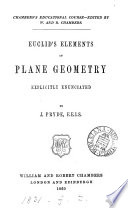 | Euclides - 1860 - 288 pages
...10). PROPOSITION XII. THEOREM. If any number of magnitudes be proportionals, as one of the antecedents is to its consequent, so is the sum of all the antecedents to that of the consequents. Given A : B : : C : D, and C : D : : E : F ; to prove that A:B::A+C + E:B... | |
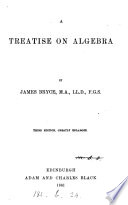 | James Bryce - 1861 - 376 pages
...± a : b : : d ± с : d. 184. When any number of quantities are proportionals, as one antecedent и to its consequent, so is the sum of all the antecedents to the sum of all the consequents. Let there be any number of proportionals, a :b : : с : d : : e :f ; then ad = bc, and af=be; also ab = ba; therefore,... | |
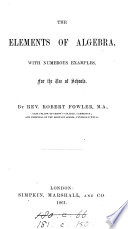 | Robert Fowler - 1861 - 426 pages
...a : I : : m : t. xi. When any number of magnitudes are proportionals, as any one of the antecedents is to its consequent, so is the sum of all the antecedents to the sum of all the consequents. Let a : Ъ : : с : d : : e : f, Then shall о : Ъ : : a + с + e : Ь + d +f; а с а е For =- = -... | |
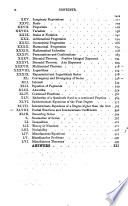 | Isaac Todhunter - Algebra - 1866 - 580 pages
...— d' or a + b : a — b :: c + d : c — d. 397. When any number of quantities are proportionals, as one antecedent is to its consequent, so is the...antecedents to the sum of all the consequents. Let a : b :: c : d :: e : f; then a : b :: a + c +e : b + d +f. For ad=bc, and af= be, (Art. 386), also... | |
 | James Pryde - Navigation - 1867 - 506 pages
...a c—da — b c—d 42. THEOREM. — If there be any number of quantities which are proportional, as one antecedent is to its consequent, so is the...the antecedents to the sum of all the consequents. _,. ace , a a+ с +е Given ъ = -d=j; to prove that y = T . a ce Then since -r = r, .'. a = rb; and... | |
 | Isaac Todhunter - 1870 - 818 pages
...ab cd or a + b : a — b :: c + d : c — d. 397. When any number of quantities are proportionals, as one antecedent is to its consequent, so is the...antecedents to the sum of all the consequents. Let a : b :: с : d :: e : f; then a : b :: a+c + e : For ad=bc, and o/= be, (Art. 386), also ab = ba ;... | |
 | James Bryce - 1872 - 386 pages
...: :d :d± c, and b ± a : b : : d ± с : d. 184. When any number of quantities are proportionals, as one antecedent is to its consequent, so is the sum of аи the antecedents to the sum of all the consequents. Let there he any number of proportionals, a... | |
 | Thomas Kimber - 1874 - 352 pages
...proportionals ? Prove that if any number of quantities be in continued proportion, as one of the antecedents is to its consequent so is the sum of all the antecedents to the sum of all the consequents. 9. Prove the rule for finding the sum to и terms of an arithmetic series of which the first term and... | |
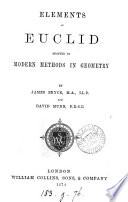 | Euclid, James Bryce, David Munn (F.R.S.E.) - Geometry - 1874 - 236 pages
...alternating the terms, as AB is to OP so is BC to PQ, so is CD to QE, etc. Wherefore as AB is to OP so is the sum of all the antecedents to the sum of all the consequents, that is, AJ3 is to OP as the perimeter of BE to the perimeter of PS (V. 8). PROP. XVIII.— PROBLEM.... | |
 | 1877 - 188 pages
...proportionals ? Prove that if any number of quantities be in continued proportion, as one of the antecedents is to its consequent so is the sum of all the antecedents to the sum of all the consequents. 9. Prove the rule for finding the sum to n terms of an arithmetic series of which the first term and... | |
| |